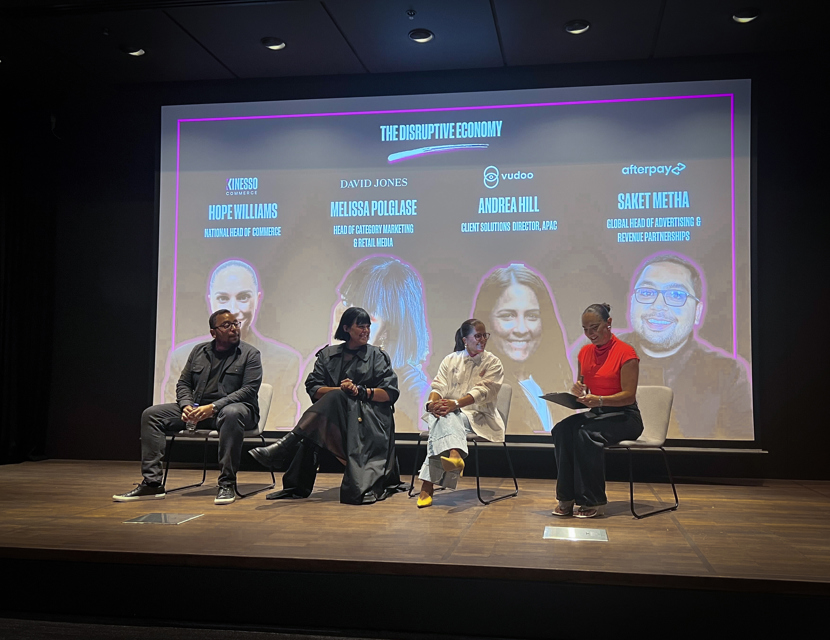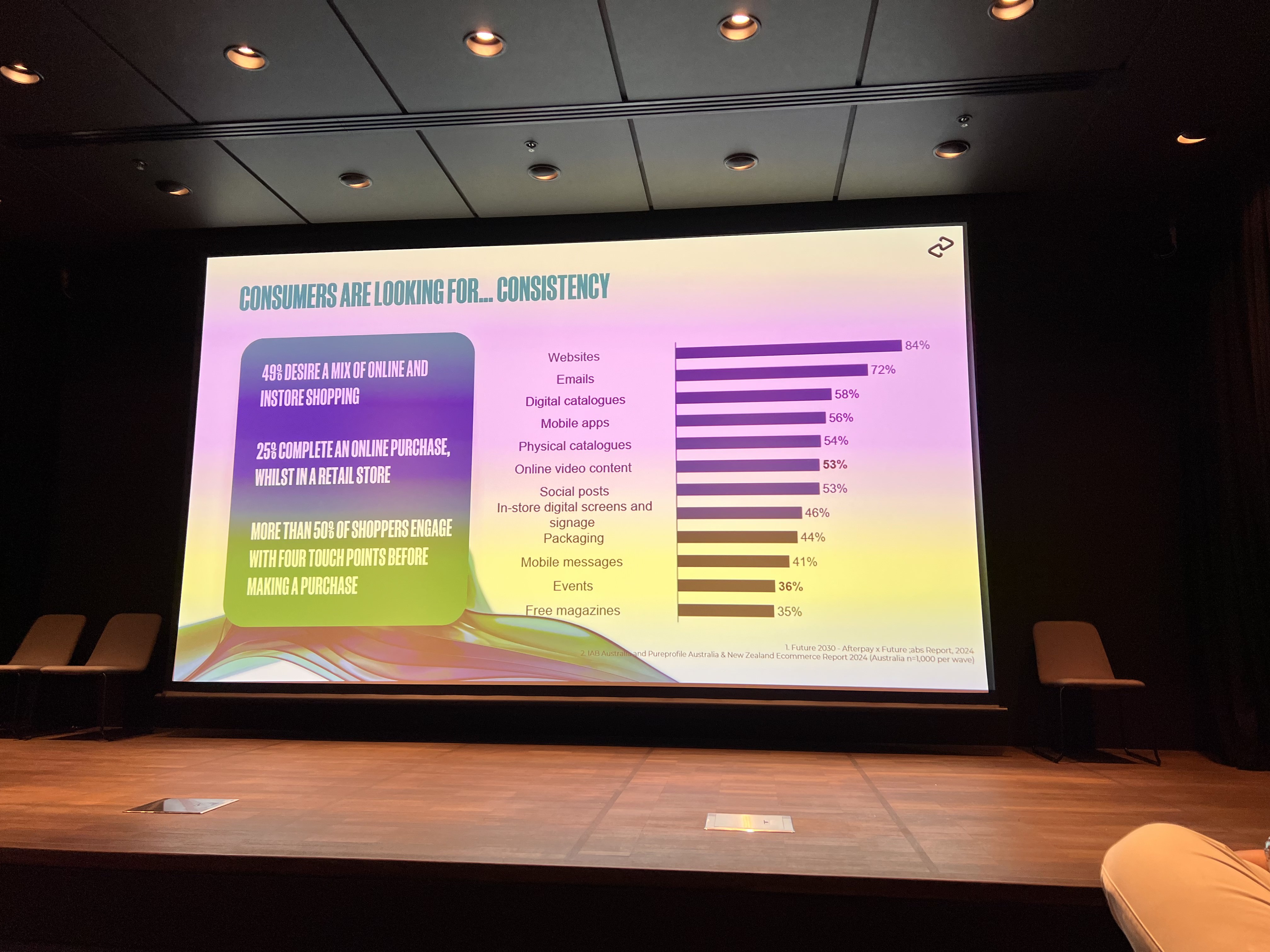
Cultivating Commerce: Insights from the IPG Commerce Economy Session
Vudoo recently attended IPG Kinesso's Commerce Economy session, which analysed the constantly changing landscape of commerce in Australia and the world at large.
The root causes of these developments have been the ongoing disruptions in the digital space, including evolving consumer behaviours, challenging economic tides, and emerging mediums.
An expert panel – represented by agencies, retailers and yours truly – delivered their findings on how top brands are staying ahead of their competitors and the tools and strategies they’re using to adapt to the new “Commerce Economy”.

Touch points are evolving—today’s consumers expect to interact wherever they are
Audiences are Active and Expect More
Passive audiences are so passé. Ready and willing consumers expect authentic brand experiences and frictionless transactions at their fingertips IRL and URL. Saket Metha, Global Head of Advertising & Revenue Partnerships at Afterpay, highlights the rise of the “Expectation Economy” whereby consumers are increasingly switched on to getting the best bang for their buck beyond just the product itself. For savvy shoppers, it all comes down to these core needs:
- Personalisation: content and products should be relevant and tailored to individuals’ browsing and shopping habits.
Trust and Convenience: easy exchange, free shipping, returns and fast checkout are non-negotiables in building trust.
Value and Flexibility: discounts, rewards and flexible payment options like buy now, pay later (BNPL) is more critical than ever to maintain loyalty.
Community Engagement: brands fostering authentic communities has an increasingly important effect on shoppers.
Consistency: Shoppers are aware of an omnichannel experience, even if they don’t know the technical term.
This baseline expectation now sets the standard in not only retail but across other industries where commerce and consumption is happening, especially online:
Hospitality: 80% of consumers are finding new venues using food delivery apps.
Healthcare: remote access to online pharmacies and telemedicine services continues to enhance accessibility and patient engagement.
Logistics: delivery providers literally cover the last mile in getting goods to consumers and are critical to their positive experience with a brand.
Finance: cash is no longer king and card is playing second fiddle to mobile wallets and BNPL services, which now account for over 50% of e-commerce payments in Australia.
Entertainment: Connected TV is booming and entertainment is becoming more interactive and shoppable.
Because of this, the concept of commerce is no longer just about e-commerce or digital shopping. It’s about influencing and enabling purchases wherever consumers are online and offline.
Disruptions to the Status Quo
Enlightened consumers are only one part of the new tide sweeping over the commerce landscape. They’re also actively discovering new platforms and marketplaces to engage and shop on: 77% of Millennials and Gen Z use marketplaces such as Temu to discover new brands. They’re using it so extensively that it was the most-downloaded app of 2024 in Australia, USA, the UK, Germany, France, and Italy.
This digital nativity has also been clocked by brands who are realising that enabling commerce through emerging channels and formats is the key to success. The finish line – a transaction – doesn’t only appear at the end of the customer journey. It’s akin to a race to make consumers obtain what they want faster and easier.
The ways in which commerce is being disrupted include:
The crumbling of cookies: Melissa Polglase, Head of Category Marketing & Retail Media at David Jones Amplify, says because third-party data has plummeted in value, first-hand intent insights such as consumer interactions and cart size are much more relevant for brands.
Growth of BNPL: as consumer usage of flexible payment options increases, so does cart size.
Commerce on Connected TV: Our Client Solutions Director, APAC, Andrea Hill, shared a Vudoo innovation that creates a seamless path from awareness to conversion by enabling connected TV viewers to use QR codes to check out Amazon carts.
Turning intent signals to action: By tracking engagement and commerce signals, brands can predict what consumers want next and optimise content and placements accordingly.
Commerce has evolved to embed seamless shopping experiences into content, media and payment ecosystems. Every consumer touchpoint is now a commerce opportunity, and brands must match pace with shifting expectations or risk losing market share.

Saket Metha, Melissa Polglase, Andrea Hill, and Hope Williams unpacking the disruptive economy
Brands Need to Adapt or Die
New mediums offered by the rise of retail media networks are actively challenging brands to keep up with their delivery of customer experiences, goods and services. Latching onto consultant-advised best practices to overcome these disruptions will only get brands so far and put them at risk of becoming statistically average.
Successful brands and technology vendors are implementing mechanisms to enable real-time interactions and transactions when customers engage with digital content:
Live Content to Cart: NBC and Lacoste enabled fans to shop Novak Djokovic’s outfits during the French Open via QR codes.
Lens the Look: An activation in Netflix show Emily in Paris encouraged viewers to use Google Lens to scan and shop characters’ outfits.
Shoppable Entertainment: Short form, long game. Walmart’s 23-episode “Add to Heart” rom-com(merce) showcased over 300 of the big-box retailer’s products for viewers to shop while watching.
Remote Shoppable Ads: Amazon Ads allows Prime Video viewers to add items to Amazon cart via TV remote.
Shopping While Gaming: Roblox integrated real-world shopping into virtual gaming worlds using Shopify.
Vudoo instream checkout: Kmart used Vudoo for the twofold benefit of seamless checkout and intent tracking to optimise content engagement and expand conversion opportunities.
Commerce has evolved from transactional events to incorporate experience-driven moments. The downstream result is the hybridisation of previously siloed brand and performance strategies into one marketing magnet through creative assets disseminated across multiple platforms. This emerging practice is invigorating brands and agencies globally to place authentic storytelling back in the forefront, with Creative Commerce becoming the fastest-growing category at Cannes Lions International Festival of Creativity.

Netflix teamed up with Google Lens to make outfits shoppable for hit series, Emily in Paris.
The Future of the Commerce Economy
As consumer demand grows, brands and agencies need to continue being strategic about their market activity to ultimately create compelling content underscored by commerce opportunities. The flattening of the funnel means efficiency and speed needs to match the rate at which consumers transact and the methods they use to do so.
Understanding customer behaviour, adapting to changing conditions and weathering the storm boils down to planning, execution and maintenance through strategy and technology. How will you cultivate commerce?